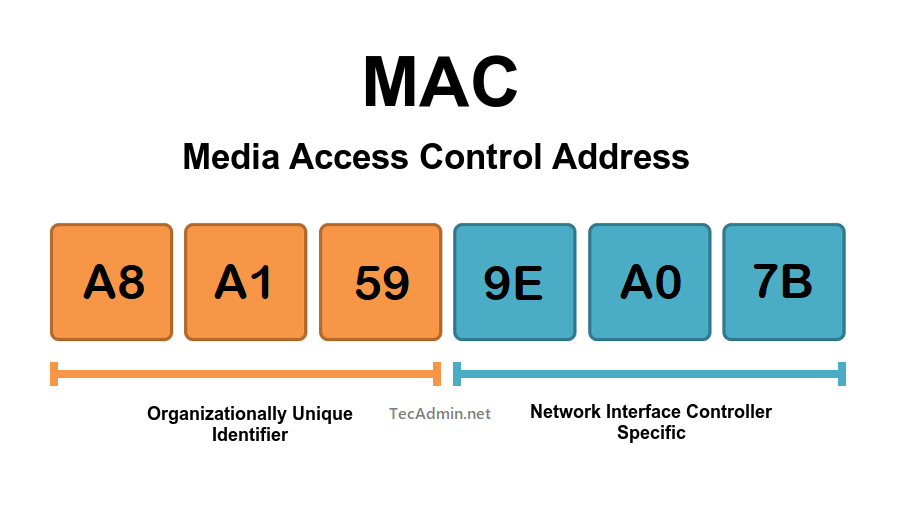Understanding the function and importance of MAC addresses is essential for anyone dealing with computer networks, be it a home network or a complex business setup. This article provides a comprehensive guide on Media Access Control (MAC) addresses, their role in network communication, and their significance in today’s digital world.
What is a MAC Address?
A MAC address (Media Access Control address) is a globally unique identifier assigned to a network interface controller (NIC) for communications on the physical network segment. These addresses are used in most network technologies, including Ethernet, Wi-Fi, and Bluetooth.
A MAC address comprises six groups of two hexadecimal digits, separated by colons, hyphens, or no separator. The first three groups (24 bits) often represent the manufacturer identification number, while the remaining three groups (24 bits) represent the device’s unique identifier assigned by the manufacturer.

How does MAC Addresses Work?
MAC addresses play a crucial role in the data link layer (Layer 2) of the Open Systems Interconnection (OSI) model. This model is a conceptual framework that standardizes the functions of a communication system into seven distinct categories or “layers.”
When a device wants to communicate with another on the same network, it uses the MAC address to locate and identify the intended recipient. In this way, MAC addresses function like a house’s street address: they tell devices where to find and send the information.
MAC Addresses Types
There are basically three types of MAC addresses:
- Unicast MAC Address
- Multicast MAC Address
- Broadcast MAC Address
1. Unicast MAC Address
Unicast MAC addresses are unique identifiers assigned to individual network interface cards (NICs). When a frame is sent to a unicast address, it is only delivered to the interface associated with that address. This is the most common type of MAC address and the one most people refer to when discussing a device’s MAC address. It’s the physical, or hardware, address for a device on the network.
2. Multicast MAC Address
Multicast MAC addresses are used when a single packet is to be sent to a group of devices, not to all devices on the network, but only to those that belong to the multicast group. Multicast addresses in Ethernet, Wi-Fi, and Bluetooth are distinct from unicast addresses as they have the least significant bit of the first octet in the address set to 1. This is useful for optimizing network traffic when sending the same data to multiple recipients, such as streaming video or performing operating system updates on a network.
3. Broadcast MAC Address
The broadcast MAC address is a special type of MAC address that allows data packets to be sent to all devices on a network segment. In an Ethernet network, the broadcast address is all binary ones, represented as FF:FF:FF:FF:FF:FF in hexadecimal form. Broadcast addresses are typically used when a device needs to send a packet to every device on the network, such as during the initial DHCP process when a device is requesting an IP address.
MAC Address vs. IP Address
Although MAC addresses and IP addresses are both used for network communication, they serve different functions. An IP address (Internet Protocol address) is used for identification and location at the network layer (Layer 3) of the OSI model. It can change depending on the network to which a device is connected.
On the other hand, a MAC address is burned into the NIC and remains constant regardless of the network or location, serving as a unique identifier for the device on a local network.
Why are MAC Addresses Important?
- Device Identification: Each device on a network must have a unique identifier. For most hardware, this unique identifier is the MAC address. It helps to accurately route packets of data from their source to their destination.
- Security: Network administrators can use MAC addresses for security purposes. For instance, they can restrict network access to specific MAC addresses (a technique known as MAC filtering) or track a device’s network activities.
- Troubleshooting: MAC addresses are invaluable in network diagnostics. They can help identify problematic devices, understand network traffic patterns, and resolve connectivity issues.
Changing and Spoofing MAC Addresses
Despite being hard-coded into a device, MAC addresses can be changed or “spoofed” using software. This practice can be useful for protecting privacy, testing networks, or circumventing network restrictions. However, it can also be misused for malicious activities, such as evading tracking or infiltrating protected networks.
Conclusion
Understanding MAC addresses is integral to understanding how devices communicate and interact on a network. These unique identifiers are crucial for routing data correctly, enhancing network security, and diagnosing connection issues. As we continue to connect more devices to networks—ranging from computers and smartphones to IoT devices—the importance of the humble MAC address only grows.